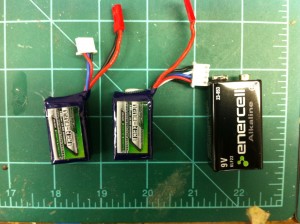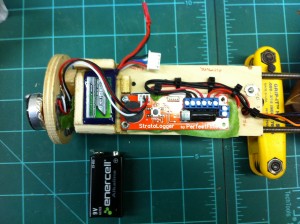(December 26, 2012 – Cuyahoga Falls)
After the hair raising shakedown flight of Nesaru X6 / Zephyr last November, all of my rockets were grounded pending a look into the failure mode of the power systems on board Nesaru, and an effective solution.
A final verdict on the failure mode
In a nutshell, the power system problem was due to the colder temperatures causing diminished performance with the on-board batteries. This prevented the black powder charges from firing at apogee, and at the per-determined altitude for the deployment of the main parachute.
The temperature wasn’t at an extreme cold, but “cold enough”. 40° F (about 5° C), was cold enough to cause the on-board batteries to run at an extremely diminished capacity.
Studies by Engineers at my place of employment confirmed this (they had a blast troubleshooting this issue!).
It has been determined that the best “all weather battery” for the job is the Lithium Polymer battery. Even the tried and true Alkaline 9 volt battery, which has been the staple power plant for rocketry electronics for years showed to be almost marginal in cold temperatures. Lithium Polymer can provide power in cold temperatures with ample amounts of “headroom” to spare when used in extremely cold temperatures.
On that note, the supplies were ordered, and a multi-week long project began to retrofit Nesaru, and Nala1 to operate using Lithium Polymer batteries.

Lithium Polymer batteries for Nesaru X6 and Artemis / Nala1. A 9 volt battery is shown for comparison.
Not only are Lithium Polymer (LiPo or LiPoly) batteries better in the cold weather, they are also capable of supplying many tens of amps of power at an instant. This is much more than what the “model rocketry standard” 9 volt battery can supply, and way more than the A-23 batteries I’ve been flying can deliver.
Nesaru required only a few modifications to support the LiPo battery retrofit, while Nala1 needed a longer electronics bay to properly accomodate one. As a result, Nala1 will be a few inches longer than before.
The weight of the lithium polymer battery is heavier than the A-23 itself, but only a couple of ounces heavier than the A-23 battery, it’s holder, and the hardware (screw and nut) to mount it to the electronics sled. This should pose no real impact to the performance of either rocket.
Nesaru’s launch weight is about 4 pounds. Nala1 1.5 pounds. The additional ounce or two won’t make much of a difference.
Work is expected to be completed to both rockets in time for a mid January launch for both rockets from O’Reily field.
((( )))
